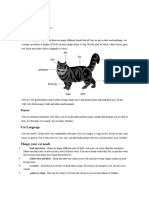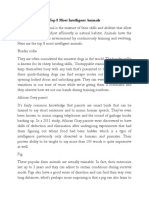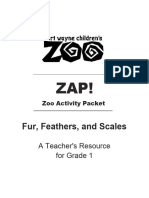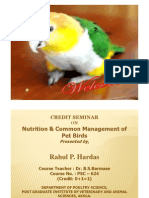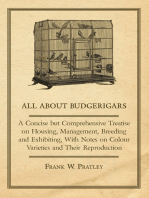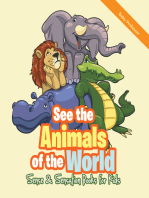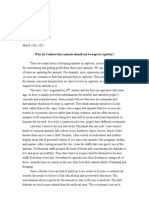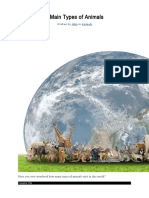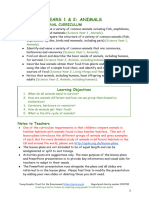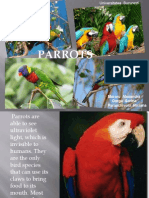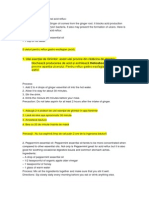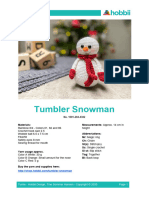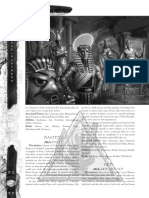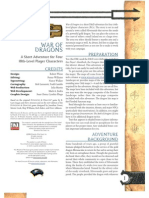Environmental Enrichment For Pet Parrots By: Jessie Zgurski
Environmental Enrichment For Pet Parrots By: Jessie Zgurski
Uploaded by
Zuri AgCopyright:
Available Formats
Environmental Enrichment For Pet Parrots By: Jessie Zgurski
Environmental Enrichment For Pet Parrots By: Jessie Zgurski
Uploaded by
Zuri AgOriginal Title
Copyright
Available Formats
Share this document
Did you find this document useful?
Is this content inappropriate?
Copyright:
Available Formats
Environmental Enrichment For Pet Parrots By: Jessie Zgurski
Environmental Enrichment For Pet Parrots By: Jessie Zgurski
Uploaded by
Zuri AgCopyright:
Available Formats
Environmental Enrichment for Pet Parrots By: Jessie Zgurski
Environmental Enrichment: Term used by zookeepers or keepers of exotic pets to describe efforts made to improve the living conditions their animals. This is important to the well-being of captive wildlife, because most wild animals spend all day searching for food or a mate, or looking after their young. Wild parrots generally live in large flocks, fly miles each day in search of food and water, and often have young that require a great deal of care. Captive parrots often have trimmed wings, no need to forage, no same-species mate, or no young to care for. As a result, they can be prone to boredom. However, by giving pet parrots an enriched environment, including a wide variety of food, and toys, opportunities to play, and plenty of attention, they can lead happy lives as pets. In the past decade or so, many studies on a large variety of species have shown that an enriched environment benefits an animal in many ways. Animals in an enriched environment, as opposed to one with only food and water available, are healthier and better adjusted than animals in a dull environment. For instance, in one study, young rats raised in an enriched environment with toys, opportunities to forage, and places to climb had slightly larger brains with more neural connections than rats raised with no toys, and only food and water. Parrot owners have long assumed that their animals would benefit from having large cages well-stocked with toys and plenty of attention from their people. This has also been proven scientifically. A study was done on orange winged Amazons (Amazona amazonica) which suggested that parrots in an enriched environment are happier and have healthier plumage than parrots with no toys. The study started with two groups of eight 16-week old Amazons. One group (Group A) had access only to food and water in bowls, and a couple of perches. The second group (Group B) had to "forage" for some of their food, and they also had toys to chew, climb and swing on. New foods were placed in different places in the cage, and in some cases, the parrots had to chew through barriers or pull levers to get at food. The parrots in the enriched group were at first wary of the different things in their cages. However, they soon figured out how to get at the food and learned to enjoy playing with their toys. The plumage quality of each parrot was recorded throughout the study. After a year, six of the eight Amazons in the unenriched environment began to shred or pluck their feathers. None of the Amazons in the enriched group did this, and all of them had excellent looking plumage. The researchers were able to reverse the effects of feather picking in the six Amazons
that did feather pick by putting them in the enriched environment. They were scared of their new surroundings at first, but were soon playing with their toys and foraging for food. After several months they stopped chewing at their feathers. Each Amazon had been examined by a veterinarian to ensure that the feather chewing was not the result of an undiagnosed medical problem. The parrots all received a healthy, balanced diet (Roudy-Bush pellets supplemented with fruits, vegetables, and nuts) so the feather picking was not the result of any nutritional deficiencies. This study suggests that, with things to do, parrots are less likely to chew their feathers. This does not mean that all cases of feather picking are due to an impoverished environment, because it is occasionally seen in very well-cared for parrots. However, it does seem that providing an enriched environment makes it less likely to occur. The researchers also noted which parrots developed stereotypical behaviors and which ones did not. Stereotypical behaviors are functionless, unvarying, repetitive behaviors that are often displayed by captive animals. These include things like pacing, headbobbing, flipping over, or self-mutilation. In the orange winged Amazon study, stereotypies included pacing, climbing in a circle, flipping around in one corner of the cage, and repeatedly chewing on cage wire in one spot. The Amazons in the unenriched cages displayed far more stereotypic behavior that the ones in the enriched cages. Another study using the same orange-winged Amazons demonstrated that when young birds are raised in an enriched environment, they are less likely to be afraid of new objects later on. So, it is important to give a young parrot plenty of toys, different types of food, and positive attention. This is true for most animals. Experiments on rats, puppies, and chickens have shown that animals in a plain environment are more skittish and less curious than ones raised in an enriched environment. Baby parrots, in particular, learn a great deal from their parents in the wild, such as which plants, fruits and seeds are good to eat. In captivity, we are the surrogate parents and need to teach the parrots to interact with people properly, and what kinds of food are healthy to eat. Enrichment is also very important for pet parrots because they are very intelligent. With nothing to do but sit in a cage, a parrot can become extremely bored and frustrated. Along with crows, ravens, magpies, and jays, they are among the smartest of all birds. For example, an African grey parrot (Psittacus erithacus) named Alex, who lives in the lab of Dr. Irene Pepperburg, has been taught to recognize several colors, shapes, objects, materials, and foods. He also can, if presented with two objects of different sizes, and colors, can tell you which one is the bigger or smaller one. And, if shown two objects of the same size and different color, if asked what's different, he'll likely tell you "color." He knows what same and different mean, and he even seems to know what none means. This is even difficult for primates to learn. The studies with Alex have also shown us that parrots can be more than mindless mimics. Other parrots Griffin and Wart, two other African grey parrots from the Pepperburg lab, are learning object labels as well. They learn these by what's called the "Model/Rival"
technique. Two people are needed for this. Let's say we want to teach the parrot what a nut is. First, the bird has to be able to pronounce the word "nut." One person asks the other person, "What's this?" The second person says, "Nut." The first person praises the second person and gives her the nut. This is repeated a few times, and then the people switch places, with the opposite person asking "What's this?" Then, they try with the parrot. If he answers with "nut" he gets the nut. If not, he's told "no." This can take a lot of patience. The behavior of parrots in the wild is also quite complex. For example, spectacled parrotlets (Forpus conspicillatus) have very complicated social systems in the wild, and they actually have various vocalizations they use to call their different friends and family members. For example, one parrotlet used one call to summon his mate, and two different ones to summon his offspring. The parrotlets used to study this phenomenon were captive-born but were kept in vary large aviaries that mimicked their natural habitat as close as possible. Wild yellow-naped Amazons (Amazona auropallita) and wild St. Lucia Amazons (Amazona versicolor) learn most of their vocal repertoire from other parrots, and as a result, different populations have different dialects of calls.
How to Provide Enrichment for Pet Parrots: 1) Chewing. Parrots generally love to chew and shred things. This is because they often have to chew shells or peels to get at their food in the wild. The vast majority of parrots also make their nests in tree hollows in the wild. So, they often have to chew out the tree hollow to make it bigger. Parrots in pet situations often have a strong drive to chew things up during the breeding season. Chewing also serves to keep their beaks trim. It's easy to provide things for a parrot to chew up. Unsprayed, non-toxic branches are great for this purpose. Just get some and attach them to the parrot's cage. All my parrots love branches, and peel the bark off of them and shred them up. The small birds (lineolated parakeets linnies:) prefer to just peel bark off of twigs. Plain cardboard works too. Small parrot species (like my linnies) often like to shred cardboard because their beaks cannot break wood. I put square cardboard pieces on a leather string, and the linnies shred it. I make sure that there is no glue on the cardboard, as some glue is toxic to parrots. Plain paper is fine as well - some parrots will pull it through into their cage if you put it on top of the cage. Some parrots love to shred old phone books. It's easy to make hanging wood toys with a drill and some sisal, cotton, or hemp rope, or plain vegetable-dyed leather string. Just drill holes in the wood and pull the rope through. You can also add pieces of vegetable-dyed leather, rawhides, knotted ropes, or beads. Use non-toxic food colouring or kool-aid to add colour if desired. I blot off all extra dye. Wood from places like Rona or Home Depot can be used to make toys if the wood has not been sprayed with chemicals like fungicides.
Some birds love to shred and destroy peacock feathers. Lucy, my conure, loves them. Just be sure they are natural and not sprayed with chemicals, like a mite spray. Ebay.com is a decent source for these. Petsmart has them as well. Twigs or popsicle sticks make good food toys for parrots that like to hold things in their feet and shred them. Clean pine cones are good for this too. Many parrot owners briefly bake pine cones in the oven to kill any pathogens or insects they may harbor. 2) Foraging. Pellets are supposed to be a good complete diet for parrots, but eating nothing but pellets for 20-70 years would be boring for a parrot. In the wild most parrots tend to eat foods from 50 or more plant species. This is especially true for the tropical species from the Pacific islands, Africa or South America. Food can be presented in interesting ways besides putting it in a dish. Kabobs work well for this - place big slices of veggies on a stick or a blunt-edged skewer and put it in the cage. You can also use a clip to put collard greens, kale, broccoli, or other veggies in different places in the cage. Sometimes presenting food in interesting ways encourages parrots to try new foods. My linnie, Garnet, wouldn't touch broccoli until I clipped it up. You can also try placing goodies (like seeds or nuts) in a bag or box for the parrot to rip open. You may first have to show the parrot that there is food in the bag or box before hell try to open it. You can also wrap food in a tortilla shell. Nuts in the shell are great because the parrot has to work to get at them. I plan to stock up on these after Christmas when they are cheap. Its also easy to make a toy out of a coconut shell just break a coconut in half, and maybe let the bird eat the flesh. This is great for large macaws, which need more fat in their diets than other parrots. The hollow shell can then be used as a toy just drill a hole in the bottom and suspend it from a rope and put goodies (like grain or seeds) in there. You can also make a "honey stick" like the ones sold in pet stores but with peanut butter or flour paste. Spread peanut/almond butter or a paste made of flour and water on a pine cone or stick, and roll it in seeds. You can also drill holes in a hunk of wood and jam nuts in there. Since seeds and nuts are quite fatty, be sure not to over feed these to your parrot. I use them as a treat a few times as week. Sometimes, Ill spread seeds on a clean surface and let the parrots find them and eat them. 3) Climbing Many parrots love climbing toys. These can include things like cotton ropes, swings, boings, or ladders. Many cockatoos absolutely love large swings and will hang on them and flap their wings to make them swing. Other parrots may love to do this as well. Its best to place a swing outside of a cage where theres more room for the bird to
swing around, but swings can work fine in large cages. Its possible to make swings with materials found at a hardware store. For small or medium birds, its possible to make a swing from a hanger. Bend the hanger in a circle and wrap cotton or sisal rope tightly around it. A quick note on rope safety: Make sure the parrot cant somehow get itself wrapped up in the rope or in loose threads. All my parrots rope toys are outside of the cage, so I am always supervising them while they use them. 4) Other Toys Some parrots like mirrors as toys, but others might become too attached to them. Others (like my conure, Lucy) try to attack them, and in such a case, are best not used as toys. My Amazon, Ripley, likes to beat up stuffed animals, but since she could swallow the stuffing, I only let her play with them when I am watching her. Some parrots love bells just make sure the parrot cant get his head stuck in them or chew off the clapper. Some toys intended for babies or toddlers are fine for parrots because they have to be safe and free of small parts easy to swallow. They also have to be made with non-toxic dyes. Be sure to avoid anything made of soft rubber rubber is very bad for parrots if they chew it off and eat it (this is true for ferrets as well). 5) Interacting with your Parrot Parrots are extremely social creatures and should have either a human or another parrot to interact with daily. There are many ways to interact with your parrot, aside from the obvious ones like holding and petting her: Teach your parrot tricks. If you are patient and use only treats and positive reinforcement, your parrot will enjoy learning some tricks. Some very outgoing parrots seem to enjoy performing for people. Sing or play an instrument. Some parrots will try to sing along! Ripley, my Amazon, will whistle along with a recorder when I play it, even though I cant play it very well. Some parrots will even dance to music. Lucy, my conure, seems to love upbeat Cuban or Latin American music and will bop her head to it. Read to your parrot. Seriously! Some parrots respond to this quite well. Encourage your parrot to flap her wings while you hold her up or walk with her. This is great exercise and helps keep wing-trimmed parrots in shape. Of course, an untrimmed parrot can be encouraged to really fly if its safe. Some parrots like to play like puppies. Trying rolling or tossing a ball for them to chase, or drag a toy on a string for them to try to get. Note that some parrots hate being on the ground (like all of mine) so this wont work for all parrots. Some parrots like reverse-fetch they toss a toy, and you go get it. Parrots also like to simply be with their owners while they do other things, like read, or watch television.
6) Outings Very outgoing parrots may love going on outings to pet stores, book stores or video stores. Almost all parrots love to be outside just be sure to either use a secure cage or aviary or be sure the parrots wings are trimmed. Even if they dont go out much, every pet parrot should get some out of cage time daily. Having a play gym makes this easier. This is a spot where the parrot can perch and play with toys that are different from the ones in its cage. These can be purchased or made. My husband and I made one from a square of untreated plywood, a square wooden rod and some branches cut off of a tree. We fastened the wood rod upright in the middle of the plywood square and attached some branches along the side of it in a spiral fashion. Ripley really enjoys this new playstand and we made it with less than $5 worth of materials. 7) Showers Showers are part of the basic necessary care for a pet parrot, but I place them under enrichment because many parrots just love them. Ripley the Amazon laughs, trills, whistles, and sings exuberantly while she has a shower. My linnies love a shower as well and hang upside down and spread out their wings so they get wet all over while I spray them. Some parrots, like my conure, prefer to bath in a shallow dish of water. Conclusion Parrots tend to be very active, intelligent animals, and need a varied diet, lots of toys, and plenty of attention to be happy as pets. Parrots without toys or a human or avian companion can become depressed, bored, or frustrated, and some of them will pull out their own feathers. A large cage with plenty of toys, a varied diet and daily attention from their human owner can help parrot stay happy and healthy. Further Reading (Links, Books, Articles, and Magazines) Environmental Enrichment (Orange Wing Amazon Studies) http://vein.library.usyd.edu.au/links/Essays/2003/perin-vale.html http://www.parrotchronicles.com/julyaugust2004/research.htm Meehan, C. C., Garner, J. P., and Mench, J. A. 2004. Environmental enrichment and development of cage stereotypy in Orange-winged Amazon parrots (Amazona amazonica) Developmental Psychobiology 44: 209-218. Intelligence of African Grey Parrots:
http://www.mecca.org/~rporter/PARROTS/grey_al.html http://www.alexfoundation.org - The Alex Studies by Irene Pepperburg - Alex and Friends: Animal Talk, Animal Thinking by Dorothy Hinshaw Patent (This is a book written for teenagers 12 and up). - Both of these books are available from the Alex Foundation website. Wild Parrots http://dsc.discovery.com/news/briefs/20050711/birdname.html http://www.freeparrots.net/parrots/ Wanker, R., Sugama, Y., and Prinage, S. 2005. Vocal labelling of family members in spectacled parrotlets, Forpus conspicillatus. Animal Behaviour. 70: 111-118. Make Your Own Bird Toys http://www.birdsnways.com/birds/ideas.htm Parrot Toys and Play Areas by: Carol DArezzo (Available from the World Parrot Trust Website, http://www.worldparrottrust.org/publications/books.htm )
You might also like
- Rabbits For Kids: Amazing Animal Books For Young ReadersFrom EverandRabbits For Kids: Amazing Animal Books For Young ReadersRating: 4.5 out of 5 stars4.5/5 (2)
- Puppy ManualDocument21 pagesPuppy Manualaly100% (1)
- Hema LabDocument13 pagesHema LabRothessa CaringalNo ratings yet
- Saurians in Africa 1921Document1 pageSaurians in Africa 1921knrckrNo ratings yet
- Lovebird Agapornis Fischeri (PDFDrive)Document7 pagesLovebird Agapornis Fischeri (PDFDrive)khurramraza75No ratings yet
- Parakeets And Budgies: Raising, Feeding, And Hand-Training Your KeetFrom EverandParakeets And Budgies: Raising, Feeding, And Hand-Training Your KeetRating: 4.5 out of 5 stars4.5/5 (2)
- Parakeets And Budgies – Raising, Feeding, And Hand-Training Your KeetFrom EverandParakeets And Budgies – Raising, Feeding, And Hand-Training Your KeetRating: 4 out of 5 stars4/5 (1)
- ANIMALSDocument4 pagesANIMALSTIGLAT07No ratings yet
- Parrots For Kids: Amazing Animal Books For Young ReadersFrom EverandParrots For Kids: Amazing Animal Books For Young ReadersRating: 4.5 out of 5 stars4.5/5 (4)
- My First Book about Parrots: Amazing Animal Books - Children's Picture BooksFrom EverandMy First Book about Parrots: Amazing Animal Books - Children's Picture BooksRating: 3.5 out of 5 stars3.5/5 (2)
- Parakeet CareDocument4 pagesParakeet Caremohsen rezvanNo ratings yet
- Animals MessGuideDocument80 pagesAnimals MessGuidexba10290% (1)
- We're Going To The Zoo!: A Multi-Book Unit About The Zoo StarringDocument47 pagesWe're Going To The Zoo!: A Multi-Book Unit About The Zoo StarringFran Moreno100% (1)
- We're Going To The Zoo!: A Multi-Book Unit About The Zoo StarringDocument47 pagesWe're Going To The Zoo!: A Multi-Book Unit About The Zoo StarringmistnehaNo ratings yet
- MESS Animals1 GuideDocument81 pagesMESS Animals1 GuidekkuganeswaryNo ratings yet
- Anthropology 1020 Eportfolio Signature AssignmentDocument4 pagesAnthropology 1020 Eportfolio Signature Assignmentapi-291863752No ratings yet
- ParrotsDocument5 pagesParrotsNimra TaneemNo ratings yet
- Research Based Article On WildlifeDocument9 pagesResearch Based Article On WildlifeSandesh ShresthaNo ratings yet
- Interesting Facts About Parrots: Down Feathers AreDocument1 pageInteresting Facts About Parrots: Down Feathers AreTaniaNo ratings yet
- Furfeathscales 2Document29 pagesFurfeathscales 2Nini HlaingNo ratings yet
- Feathers and Fury: Ozun 1Document19 pagesFeathers and Fury: Ozun 1api-305450632No ratings yet
- Zebra FinchDocument6 pagesZebra Finchrstrman100% (1)
- Rahul Seminar (Compatibility Mode)Document59 pagesRahul Seminar (Compatibility Mode)rahul1809100% (3)
- Field Guide to Urban Wildlife: Common Animals of Cities & Suburbs How They Adapt & ThriveFrom EverandField Guide to Urban Wildlife: Common Animals of Cities & Suburbs How They Adapt & ThriveNo ratings yet
- Spider MonkeyDocument2 pagesSpider MonkeygalizurNo ratings yet
- Lesson Plan Objectives: Plants and AnimalsDocument7 pagesLesson Plan Objectives: Plants and Animalsvogue_52No ratings yet
- All about Budgerigars - A Concise But Comprehensive Treatise on Housing, Management, Breeding and Exhibiting, with Notes on Colour Varieties and TheirFrom EverandAll about Budgerigars - A Concise But Comprehensive Treatise on Housing, Management, Breeding and Exhibiting, with Notes on Colour Varieties and TheirNo ratings yet
- Who is pooing in my garden? A book about animals, insects, and poo!From EverandWho is pooing in my garden? A book about animals, insects, and poo!No ratings yet
- Jena Beatty - Magizine ProjectDocument15 pagesJena Beatty - Magizine Projectapi-268652510No ratings yet
- Animals Have Class: A Teacher's Resource For Grade 5Document30 pagesAnimals Have Class: A Teacher's Resource For Grade 5Gardien DatgNo ratings yet
- UWRT Portfolio-1Document9 pagesUWRT Portfolio-1Taylor MurrmannNo ratings yet
- Science Q2W7-G4Document136 pagesScience Q2W7-G4JULIE ANN CABOTAJENo ratings yet
- Phenomenal Dialogue-Style Learning Module: (A Strategic Intervention Material)Document21 pagesPhenomenal Dialogue-Style Learning Module: (A Strategic Intervention Material)CaretellNo ratings yet
- Whose Food Is This?: A Look at What Animals Eat - Leaves, Bugs, and NutsFrom EverandWhose Food Is This?: A Look at What Animals Eat - Leaves, Bugs, and NutsRating: 3 out of 5 stars3/5 (1)
- See the Animals of the World | Sense & Sensation Books for KidsFrom EverandSee the Animals of the World | Sense & Sensation Books for KidsNo ratings yet
- Amazing Amphibians: 30 Activities and Observations for Exploring Frogs, Toads, Salamanders, and MoreFrom EverandAmazing Amphibians: 30 Activities and Observations for Exploring Frogs, Toads, Salamanders, and MoreNo ratings yet
- Unit 3-2Document14 pagesUnit 3-2Syed Abbas Ali Shah BukhariNo ratings yet
- Mcleary's Spectre Husbandry Data SheetDocument2 pagesMcleary's Spectre Husbandry Data SheetAlmaNo ratings yet
- Why Do I Believe That Animals Should Not Be Kept in Captivity?Document4 pagesWhy Do I Believe That Animals Should Not Be Kept in Captivity?api-129540023No ratings yet
- 6 Main Types of Animals: Writt en byDocument15 pages6 Main Types of Animals: Writt en byAurea Jasmine DacuycuyNo ratings yet
- YEARS1&2 - AnimalsDocument23 pagesYEARS1&2 - AnimalsROCIO CHICANONo ratings yet
- The Lovebird: An Owner's Guide to a Happy Healthy PetFrom EverandThe Lovebird: An Owner's Guide to a Happy Healthy PetRating: 5 out of 5 stars5/5 (1)
- BIRDS ActivityDocument13 pagesBIRDS ActivityMudasir SalikNo ratings yet
- Proiect 1Document14 pagesProiect 1Moraru AlexandraNo ratings yet
- Relationship With Humans: Parrots, Also Known As Psittacines (Pronounced PsittaciformesDocument16 pagesRelationship With Humans: Parrots, Also Known As Psittacines (Pronounced PsittaciformesRicky RanaNo ratings yet
- Awesome Snake Science!: 40 Activities for Learning About SnakesFrom EverandAwesome Snake Science!: 40 Activities for Learning About SnakesRating: 5 out of 5 stars5/5 (1)
- HedgehogDocument3 pagesHedgehogEgamberdi EgamberdiyevNo ratings yet
- Đề Thi Tiếng Anh Vào Lớp 6 - Đề Số 2Document6 pagesĐề Thi Tiếng Anh Vào Lớp 6 - Đề Số 2Trang NguyenNo ratings yet
- 2021-2022 Assessment TLE8 Week3&4Document2 pages2021-2022 Assessment TLE8 Week3&4ARVIJOy ANDRESNo ratings yet
- ADJALEXU - Volume 43 - Issue 2 - Pages 7-12Document6 pagesADJALEXU - Volume 43 - Issue 2 - Pages 7-12Belinda SalmaNo ratings yet
- Biology Paper 1 Marking SchemeDocument5 pagesBiology Paper 1 Marking SchemeNyakweba Denis0% (1)
- Bursa City Guide 2009Document176 pagesBursa City Guide 2009wickednessNo ratings yet
- Asdfg Asdfg Asdfg Asddfg Asdfg Asdfg Asdfga Asdfg Asddfg Asdfg Asdfg Asdfg Asdffg Asdfg Asdfg Asdfg Asdfga Asdfg LKJH LLKJHDocument12 pagesAsdfg Asdfg Asdfg Asddfg Asdfg Asdfg Asdfga Asdfg Asddfg Asdfg Asdfg Asdfg Asdffg Asdfg Asdfg Asdfg Asdfga Asdfg LKJH LLKJHsohagNo ratings yet
- Describing The Various Means of Transportation.: Make A Summary of Not More Than 120 WordsDocument7 pagesDescribing The Various Means of Transportation.: Make A Summary of Not More Than 120 WordsYamini KumarNo ratings yet
- Sample Test-For SsDocument4 pagesSample Test-For SsTu NguyenNo ratings yet
- Summary Offences Act: Laws of Trinidad and TobagoDocument77 pagesSummary Offences Act: Laws of Trinidad and TobagoKerwin CaesarNo ratings yet
- Isfo Class 6 EnglishDocument64 pagesIsfo Class 6 EnglishJunaied100% (2)
- Batch Wise Lab Test Report - 2020Document4 pagesBatch Wise Lab Test Report - 2020saidurtexNo ratings yet
- Around The Sheds ExtractDocument29 pagesAround The Sheds ExtractThe Five Mile PressNo ratings yet
- Angel LESSON PLANDocument8 pagesAngel LESSON PLANGlydel FababairNo ratings yet
- The Glasses Bear PDFDocument1 pageThe Glasses Bear PDFSath BellNo ratings yet
- Cozy Solo RPG Card Oracle SystemDocument71 pagesCozy Solo RPG Card Oracle SystemJhon Andrew OganiaNo ratings yet
- Dairy Farm0Document6 pagesDairy Farm0GarNo ratings yet
- The Eerie AtticDocument2 pagesThe Eerie Atticapi-526939534No ratings yet
- FinalDocument11 pagesFinalyash rayththaNo ratings yet
- Acid RefluxDocument3 pagesAcid Refluxhmaddy3117No ratings yet
- Tumle Snemand UsDocument7 pagesTumle Snemand Usalix.moityNo ratings yet
- DND 5e DM Screen PDFDocument4 pagesDND 5e DM Screen PDFOliva MervzNo ratings yet
- Lower Extremity Venous Protocol 14Document3 pagesLower Extremity Venous Protocol 14api-276847924No ratings yet
- Community Policing As Scouting For BSF CamelsDocument5 pagesCommunity Policing As Scouting For BSF CamelsNaresh KadyanNo ratings yet
- Scion - Hero-51Document1 pageScion - Hero-51JdRNo ratings yet
- Sehat Ka Insaf: Report of The First 7 RoundsDocument4 pagesSehat Ka Insaf: Report of The First 7 RoundsPTI OfficialNo ratings yet
- D20 - D&D - Adventure - War of DragonsDocument17 pagesD20 - D&D - Adventure - War of DragonsErin Wagner100% (3)
- Y4 Unit3 Week 1 FinalDocument11 pagesY4 Unit3 Week 1 FinalTeacher2905No ratings yet









